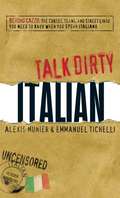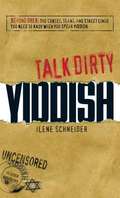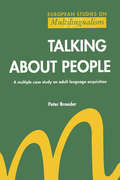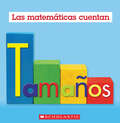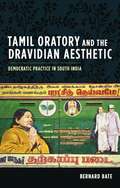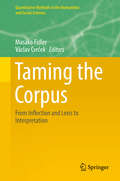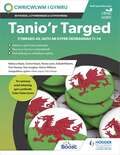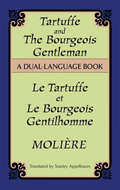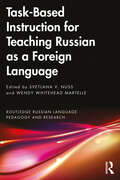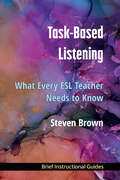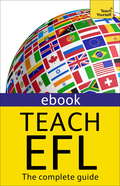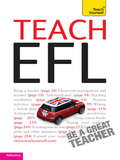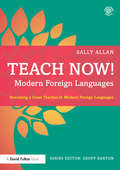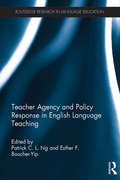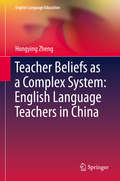- Table View
- List View
Talk Dirty German
by Alexis Munier Karin EberhardtSprechen Sie Dirty Deutsch?If you think German is all brat and no wurst, you need to think again. German is sexier--and dirtier--than you might imagine. (Think Hamburg!) From hearts and violins to pigs and dogs, Goethe's native tongue is ripe--and rank--with creative obscenities, including: Kuck mal diese geile Schnitte!Look at that sexy chick!Literal translation: Look at that sexy slice!Alle wissen dass Klaus sehr gut geigt.Everyone knows Klaus f**ks well.Literal translation: Everyone knows Klaus plays the violin well.Markus, du bist ein verdammter Schweinehund.Markus, you're a f**king moron.Literal translation: Markus, you are a damned pig dog.In this book, you receive a basic introduction into the netherworlds (and nether regions) of the true Jargon. Whether seducing a Mädchen in München or a Kerl in Köln, this gritty linguistic guide is all you need to know to talk dirty the German way.
Talk Dirty German: Beyond Schmutz - The curses, slang, and street lingo you need to know to speak Deutsch
by Alexis MunierLearn to Speak German--the Dirty Deutsch Way!If you think German is all brat and no wurst, you need to think again. German is sexier--and dirtier--than you might imagine. (Think Hamburg!) From hearts and violins to pigs and dogs, Goethe's native tongue is ripe--and rank--with creative obscenities, including:Kuck mal diese geile Schnitte!Look at that sexy chick! Literal translation: Look at that sexy slice!Alle wissen dass Klaus sehr gut geigt.Everyone knows Klaus f**ks well.Literal translation: Everyone knows Klaus plays the violin well.
Talk Dirty Italian
by Alexis Munier Emmanuel TichelliWhether they're ordering a slice in Little Italy or riding along the Grand Canal, this book will be a reader's guide to truly spitting the sauce. A collection of slang and expressions that could make Tony Soprano blush, this book helps non-native speakers sound like they just got off the boat. Each entry provides an individual foreign gem, a useful Italian sentence employing the word, the expression's English counterpart, and its literal translation. Complete with up-to-date curses, slang, and idiomatic expressions, the words and phrases are split into different situation-based sections, so the reader will always know what to say - no matter where they are.
Talk Dirty Italian
by Alexis Munier Emmanuel TichelliWhether they're ordering a slice in Little Italy or riding along the Grand Canal, this book will be a reader's guide to truly spitting the sauce. A collection of slang and expressions that could make Tony Soprano blush, this book helps non-native speakers sound like they just got off the boat. Each entry provides an individual foreign gem, a useful Italian sentence employing the word, the expression's English counterpart, and its literal translation. Complete with up-to-date curses, slang, and idiomatic expressions, the words and phrases are split into different situation-based sections, so the reader will always know what to say - no matter where they are.
Talk Dirty Italian: The curses, slang, and street lingo you need to know when you speak italiano
by Alexis MunierThis sort of Italian isn't Church sanctioned.Whether ordering a slice in Little Italy or riding along the Grand Canal, Talk Dirty: Italian is your guide to truly spitting the sauce. Loaded with plenty of words and expressions that could make Tony Soprano blush, you'll sound like you just got off the boat with entries like the one below. And with the curses, slang, and idiomatic expressions split into different situation-based sections, you're guaranteed to always know what to say--no matter where you are.Italian word: scopabile Definition: f**kable, lit. sweepable Phrase: Niente male la tua suocera; anzi direi che è propio scopabile. Literal Translation: Your mother-in-law is not so bad looking; in fact she's quite f**kable.
Talk Dirty Yiddish
by Ilene SchneiderThis is the Yiddish they didn't teach at Temple. This book gives readers the lowdown on how to really spit the Hebrew alphabet. With plenty of slang, curses, and idiomatic expressions, this book gives readers' Yiddish vocabulary a real kick in the toches.
Talk Dirty Yiddish
by Ilene SchneiderThis is the Yiddish they didn't teach at Temple. This book gives readers the lowdown on how to really spit the Hebrew alphabet. With plenty of slang, curses, and idiomatic expressions, this book gives readers' Yiddish vocabulary a real kick in the toches.
Talking About People; A Multip: A multiple case study on adult language acquisition
by Peter BroederFirst Published in 1991. Routledge is an imprint of Taylor & Francis, an informa company.
Tamaños (Math Counts, New and Updated)
by Henry PluckroseUna serie de libros para introducir a los lectores jovenes a conceptos matematicos fundamentales, ¡ahora en espanol!Usamos las palabras "grande" y "pequeno" para describir el tamano de las cosas. Por ejemplo, un conejo es mas grande que un hamster, pero mas pequeno que un pony. Con ejemplos del mundo real, fotografias convincentes y textos inspiradores, ¡esta es la introduccion perfecta al concepto matematico de "tamano" para los lectores mas jovenes!Sobre la serie:Publicada originalmente en los anos 90 y actualizada recientemente, esta revolucionaria serie superventas inicia a los ninos en el camino de aprender a comunicarse y razonar matematicamente.La base de las matematicas son las ideas, y estos libros se han desarrollado para que los ninos vean, hablen, toquen y experimenten con estas ideas. Las fotografias atractivas y el texto sencillo y directo, hacen de esta serie una herramienta perfecta para leer individualmente o en voz alta. Diez conceptos matematicos fundamentales, uno para cada libro de la serie, estan desarrollados de forma excelente, y ofrecen un apoyo curricular ideal. Esta serie es la mejor manera de iniciar el camino hacia el dominio de las matematicas.
Tamil Mozhi Varalaru
by SakthivelThis book talks about the history of the ancient language Tamil and the way it's literature flourished during different dynasities and goes on to talk about the present day Tamil.
Tamil Oratory and the Dravidian Aesthetic: Democratic Practice in South India (Cultures of History)
by Bernard BateThis is a book about the newness of old things. It concerns an oratorical revolution, a transformation of oratorical style linked to larger transformations in society at large. It explores the aesthetics of Tamil oratory and its vital relationship to one of the key institutions of modern society: democracy. Therefore this book also bears on the centrality of language to the modern human condition.Though Tamil oratory is a relatively new practice in south India, the Dravidian (or Tamil nationalist) style employs archaic forms of Tamil that suggest an ancient mode of speech. Beginning with the advent of mass democratic politics in the 1940s, a new generation of politician adopted this style, known as "fine," or "beautiful Tamil" (centamil), for its distinct literary virtuosity, poesy, and alluring evocation of a pure Tamil past. Bernard Bate explores the centamil phenomenon, arguing that the genre's spectacular literacy and use of ceremonial procession, urban political ritual, and posters, praise poetry are critical components in the production of a singularly Tamil mode of political modernity: a Dravidian neoclassicism. From his perspective, the centamil revolution and Dravidian neoclassicism suggest that modernity is not the mere successor of tradition but the production of tradition, and that this production is a primary modality of modernity, a new newness-albeit a newness of old things.
Taming Babel
by Rachel Leow"Taming Babel sheds new light on the role of language in the making of modern postcolonial Asian nations. Focusing on one of the most linguistically diverse territories in the British Empire, Rachel Leow explores the profound anxieties generated by a century of struggles to govern the polyglot subjects of British Malaya and postcolonial Malaysia. The book ranges across a series of key moments in the nineteenth and twentieth centuries, in which British and Asian actors wrought quiet battles in the realm of language: in textbooks and language classrooms; in dictionaries, grammars and orthographies; in propaganda and psychological warfare; and in the very planning of language itself. Every attempt to tame Chinese and Malay languages resulted in failures of translation, competence, and governance, exposing both the deep fragility of a monoglot state in polyglot milieux, and the essential untameable nature of languages in motion"--
Taming the Corpus: From Inflection and Lexis to Interpretation (Quantitative Methods in the Humanities and Social Sciences)
by Masako Fidler Václav CvrčekThis book bridges the current quantitative and qualitative text analyses, using grammar as a crucial source of investigation. Taking data from Czech, an inflected language, in which the most optimal conditions to respond to this research question are met, the book expands the understanding of language and text in ways that have not been executed before. For predominantly English-based quantitative research, this volume fills a crucial gap by examining the relationship between inflection and other phenomena (including discourse, translation and literature). For the current qualitative research, the volume provides large empirical data to confirm some of its claims, but more importantly, it demonstrates the important role of detailed grammatical concepts that have not been considered before. Besides addressing fundamental questions about text analysis methods, the volume presents a diverse array of Czech data that are unique in their own right and worthy of dissemination to the general audience. Taming the Corpus: From Inflection and Lexis to Interpretation is divided into three sections. Section 1 deals with phonotactics, poetic structure, morphological complexity used to differentiate literary style, and native speakers’ sense of grammaticality – issues pertinent to linguistic typology, cognition and language, and literary studies. Section 2 focuses on inter-language relations, especially the theory of translation. Section 3 demonstrates how quantitative analysis of texts can contribute to our understanding of society and connects the volume to legal language, construction of gender and discourse position and implicit ideology.
Tanio'r Targed: Cymraeg Ail Iaith ar gyfer oedrannau 11–14
by Tina Thomas Rebecca Boyle Tudur Dylan Jones Nicola Lewis Dafydd Roberts Connor Keyes Keiron Williams Sian VaughanMae'r gwerslyfr hwn wedi'i gymeradwyo gan CBAC.Anogwch fyfyrwyr i ymgysylltu â'r Gymraeg wrth iddynt ddarganfod mwy am eu gwlad, eu llenyddiaeth a'u treftadaeth, tra'n datblygu'r sgiliau gwrando, darllen, siarad ac ysgrifennu sydd eu hangen ar gyfer TGAU.Wedi'i gynllunio gan dîm o arbenigwyr pwnc, mae'r Llyfr Myfyrwyr hygyrch hwn yn dilyn dull dysgu sy'n seiliedig ar sgiliau.- Darganfod cyfoeth o adnoddau a gweithgareddau newydd: bydd y cwrs un llyfr cost-effeithiol hwn yn helpu i ddatblygu dysgwyr uchelgeisiol a galluog ac ysbrydoli cariad at y Gymraeg- Helpu pob myfyriwr i symud ymlaen gyda chynnwys gwahaniaethol sydd wedi'i gynllunio i ddarparu ar gyfer lefelau amrywiol o wybodaeth a gallu- Archwilio diwylliant, hunaniaeth a llenyddiaeth Cymru gyda'ch myfyrwyr, gan weithio drwy weithgareddau difyr sy'n eu galluogi i gael hwyl gyda thafodiaith, ysgrifennu eu barddoniaeth eu hunain a dadansoddi dramâu- Datblygu dealltwriaeth myfyrwyr o ramadeg a geirfa ar draws gwahanol gyd-destunau gyda dull seiliedig ar sgiliau o siarad, gwrando, darllen ac ysgrifennu- Gosod sylfeini cadarn ar gyfer TGAU: mae cwestiynau yn arddull PISA, fideos, llenyddiaeth, sgiliau cyfieithu a sgiliau prawf ddarllen yn cael eu cyflwyno'n raddol, gan baratoi myfyrwyr ar gyfer cynnwys a mathau o gwestiynau TGAU- Cydweithio â'ch adrannau Saesneg ac ITM gyda nodiadau athrawon sy'n dangos cysylltiadau trawsgwricwlaidd.---This textbook has been endorsed by WJEC.Encourage students to engage with the Welsh language as they discover more about their country, literature and heritage, while developing the listening, reading, speaking and writing skills needed for GCSEDesigned by a team of subject specialists, this accessible Student Book takes a skills-based approach to learning.- Discover a wealth of new resources and activities: this cost-effective single-book course will help develop ambitious and capable learners and inspire a love of the Welsh language- Help all students progress with differentiated content designed to cater for varying levels of knowledge and ability- Explore Welsh culture, identity and literature with your students, working through engaging activities that allow them to have fun with dialect, write their own poetry and analyse plays= Develop students' understanding of grammar and vocabulary across different contexts with a skills-based approach to speaking, listening, reading and writing- Lay firm foundations for GCSE: PISA-style questions, videos, literature, translations and proofreading skills are introduced gradually, preparing students for GCSE content and question types
Tanio'r Targed: Cymraeg Ail Iaith ar gyfer oedrannau 11–14
by Tina Thomas Rebecca Boyle Tudur Dylan Jones Nicola Lewis Dafydd Roberts Connor Keyes Keiron Williams Sian VaughanMae'r gwerslyfr hwn wedi'i gymeradwyo gan CBAC.Anogwch fyfyrwyr i ymgysylltu â'r Gymraeg wrth iddynt ddarganfod mwy am eu gwlad, eu llenyddiaeth a'u treftadaeth, tra'n datblygu'r sgiliau gwrando, darllen, siarad ac ysgrifennu sydd eu hangen ar gyfer TGAU.Wedi'i gynllunio gan dîm o arbenigwyr pwnc, mae'r Llyfr Myfyrwyr hygyrch hwn yn dilyn dull dysgu sy'n seiliedig ar sgiliau.- Darganfod cyfoeth o adnoddau a gweithgareddau newydd: bydd y cwrs un llyfr cost-effeithiol hwn yn helpu i ddatblygu dysgwyr uchelgeisiol a galluog ac ysbrydoli cariad at y Gymraeg- Helpu pob myfyriwr i symud ymlaen gyda chynnwys gwahaniaethol sydd wedi'i gynllunio i ddarparu ar gyfer lefelau amrywiol o wybodaeth a gallu- Archwilio diwylliant, hunaniaeth a llenyddiaeth Cymru gyda'ch myfyrwyr, gan weithio drwy weithgareddau difyr sy'n eu galluogi i gael hwyl gyda thafodiaith, ysgrifennu eu barddoniaeth eu hunain a dadansoddi dramâu- Datblygu dealltwriaeth myfyrwyr o ramadeg a geirfa ar draws gwahanol gyd-destunau gyda dull seiliedig ar sgiliau o siarad, gwrando, darllen ac ysgrifennu- Gosod sylfeini cadarn ar gyfer TGAU: mae cwestiynau yn arddull PISA, fideos, llenyddiaeth, sgiliau cyfieithu a sgiliau prawf ddarllen yn cael eu cyflwyno'n raddol, gan baratoi myfyrwyr ar gyfer cynnwys a mathau o gwestiynau TGAU- Cydweithio â'ch adrannau Saesneg ac ITM gyda nodiadau athrawon sy'n dangos cysylltiadau trawsgwricwlaidd.---This textbook has been endorsed by WJEC.Encourage students to engage with the Welsh language as they discover more about their country, literature and heritage, while developing the listening, reading, speaking and writing skills needed for GCSEDesigned by a team of subject specialists, this accessible Student Book takes a skills-based approach to learning.- Discover a wealth of new resources and activities: this cost-effective single-book course will help develop ambitious and capable learners and inspire a love of the Welsh language- Help all students progress with differentiated content designed to cater for varying levels of knowledge and ability- Explore Welsh culture, identity and literature with your students, working through engaging activities that allow them to have fun with dialect, write their own poetry and analyse plays= Develop students' understanding of grammar and vocabulary across different contexts with a skills-based approach to speaking, listening, reading and writing- Lay firm foundations for GCSE: PISA-style questions, videos, literature, translations and proofreading skills are introduced gradually, preparing students for GCSE content and question types
Tartuffe and the Bourgeois Gentleman: A Dual-Language Book
by MolièreOften called the "Father of French Comedy," Molière (Jean-Baptiste Poquelin, 1622-1673) was a master at exposing the foibles and complexities of humanity in plays notable for their dramatic construction, varied and diverse humor, and subtlety of psychological observation. This convenient dual-language volume contains the original French texts and English translations of two of Molière's most praised and popular comedies: Tartuffe and The Bourgeois Gentleman. These timeless theatrical works by one of France's greatest and most influential playwrights can be appreciated not only by students of French language and literature but by any aficionado of classic comedy.Tartuffe, a 1664 verse comedy with serious overtones, concerns a scoundrel who impersonates a holy man in order to acquire his gullible host's property and wife. The prose farce The Bourgeois Gentleman, an instant success at its 1670 debut, lampoons the hypocrisy of 17th-century Parisian society with a central character who attempts to adopt the superficial manners, accomplishments, and speech associated with the nobility. Both plays abound in humor, the quips of saucy servants, and a host of satirical plot devices.For this edition, Stanley Appelbaum has provided an informative introduction to the playwright and the plays, and excellent literal English translations on facing pages, offering students an ideal opportunity both to refine their French-language skills and to enjoy Molière in his own words.
Task-Based Instruction for Teaching Russian as a Foreign Language (Routledge Russian Language Pedagogy and Research)
by Svetlana V. Nuss Wendy Whitehead MartelleTask-Based Instruction for Teaching Russian as a Foreign Language presents the most recent developments in the field of task-based language teaching (TBLT) and highlights impactful research-based instructional practices of applying TBLT for the teaching of Russian. This comprehensive volume extends the current understanding of the nature and role of tasks in course development, authenticity in task design, the role of the instructor in TBLT, teaching culture through TBLT, the intersection of complex morphology and explicit grammar instruction with task-based approaches, collaborative interaction within TBLT, and technology-mediated tasks. This resource focuses on the unique set of factors and challenges that arise when applying TBLT in the instruction of Russian and other morphologically rich languages. This edited volume will be of interest to teachers of Russian as well as researchers in Russian language acquisition, language pedagogy, and Slavic applied linguistics.
Task-Based Listening: What Every ESL Teacher Needs to Know
by Steven BrownAre you looking for activities to use in your listening classes beyond asking students to answer comprehension questions? In Task-Based Listening, author Steven Brown defines task-based listening (TBL) and describes how to build a task-based listening program, how to create a task-based listening lesson, ways to activate vocabulary acquisition and improve grammatical knowledge, and the links between listening and pronunciation. In addition, he covers the ways that metacognitive strategies can assist students when listening, the advantages of extensive listening, and the benefits of interactive listening. Readers will find specific tips and suggestions for using these concepts in the classroom.
Teach Business English
by Penny Ur Sylvie DonnaThis book provides a practical introduction to Business English for new and experienced teachers, and deals with a range of issues from needs analysis and course planning to testing and evaluation.
Teach EFL: Teach Yourself (Teach Yourself Ser.)
by David RiddellTeach EFL is the ultimate practical reference guide to teaching English as a Foreign Language. 'Riddell's book is a classic - it answers all those questions new language teachers have. . . . covers an amazing amount in a clear accessible way. ' David Carr, Director of Teacher Training International House London This book is packed with information on: -effective teaching techniques. -sound classroom management. -practical lesson planning. -successful job hunting and career development. This is an indispensable book for all new and experienced EFL teachers: a step-by-step guide on what to teach and how to teach it. This edition has been fully revised to include: -up-to-date information on technology as an aid to learning. -comprehensive information on the increasingly popular task-based learning. -invaluable advice on making the transition from learning to teaching. -clear guidance on ongoing professional development. -useful examples of teaching in different international contexts. Rely on Teach Yourself, trusted by learners for over 70 years.
Teach English as a Foreign Language (New Edition): eBook
by David RiddellThis new edition of Teach EFL is the ultimate practical reference guide to teaching English as a Foreign Language. 'Riddell's book is a classic - it answers all those questions new language teachers have....covers an amazing amount in a clear accessible way.'David Carr, Director of Teacher TrainingInternational House LondonThis book is packed with information on:-effective teaching techniques.-sound classroom management.-practical lesson planning.-successful job hunting and career development.This is an indispensable book for all new and experienced EFL teachers: a step-by-step guide on what to teach and how to teach it. This edition has been fully revised to include:-up-to-date information on technology as an aid to learning. -comprehensive information on the increasingly popular task-based learning.-invaluable advice on making the transition from learning to teaching.-clear guidance on ongoing professional development.-useful examples of teaching in different international contexts.Rely on Teach Yourself, trusted by learners for over 75 years.
Teach English as a Foreign Language: Teach Yourself (New Edition)
by David RiddellIs this the right book for me? A course to take you from beginner to confident teacherAre you looking for a complete course in teaching English as a foreign language which takes you effortlessly from beginner to confident teacher? Whether you are starting from scratch, or are just out of practice, Teach English as a Foreign Language will guarantee success! Now fully updated to make your language teaching experience fun and interactive. You can still rely on the benefits of a top language teacher and our years of teaching experience, but now with added features within the course and online.Teach English as a Foreign Language includes:Chapter 1: Being a studentChapter 2: Being a teacherChapter 3: Classroom management and mannerChapter 4: Teaching grammar via a situational presentationChapter 5: Teaching grammar via a text or recordingChapter 6: Teaching grammar via 'test teach test'Chapter 7: Teaching vocabularyChapter 8: Checking understanding of meaningChapter 9: PronunciationChapter 10: Practice activitiesChapter 11: Receptive skills 1 - ReadingChapter 12: Receptive skills 2 - ListeningChapter 13: Productive skills 1 - SpeakingChapter 14: Productive skills 2 - WritingChapter 15: Spoken and written mistakesChapter 16: CorrectionChapter 17: Lesson planning 1 - aimsChapter 18: Lesson planning 2 - writing a lesson planChapter 19: Lesson planning 3 - anticipating problemsChapter 20: Lesson planning 4 - what would you do if...?Chapter 21: Using course books and other materialsChapter 22: Testing studentsChapter 23: Teaching one-to-oneChapter 24: DVDs and other resourcesChapter 25: Professional awareness and developmentChapter 26: Career prospects and job huntingChapter 27: A guide to levelsChapter 28: Language glossaryChapter 29: A glossary of termsChapter 30: Some useful addressesLearn effortlessly with a new easy-to-read page design and interactive features:Not got much time?One, five and ten-minute introductions to key principles to get you started.Author insightsLots of instant help with common problems and quick tips for success, based on the author's many years of experience.Test yourselfTests in the book and online to keep track of your progress.Extend your knowledgeExtra online articles to give you a richer understanding of the subject.Five things to rememberQuick refreshers to help you remember the key facts.Try thisInnovative exercises illustrate what you've learnt and how to use it.
Teach Now! Modern Foreign Languages: Becoming a Great Teacher of Modern Foreign Languages (Teach Now!)
by Sally AllanBeing taught by a great teacher is one of the great privileges of life. Teach Now! is an exciting new series that opens up the secrets of great teachers and, step-by-step, helps trainees to build the skills and confidence they need to become first-rate classroom practitioners. Written by a highly-skilled practitioner, this practical, classroom-focused guide contains all the support you need to become a great modern foreign languages teacher. Combining a grounded, modern rationale for learning and teaching with highly practical training approaches, the book guides you through all the different aspects of MFL teaching offering clear, straightforward advice on classroom practice, lesson planning and working in schools. Teaching and learning, planning, assessment and behaviour management are all covered in detail, with a host of carefully chosen examples used to demonstrate good practice. There are also chapters on the essentials of the MFL curriculum, pedagogical techniques, strategies to engage students in language learning, and how to succeed in observations and interviews. Throughout the book, there is a great selection of ready-to-use activities, approaches and techniques which will help put you on the fast track to success in the classroom. Covering everything you need to know, this book is your essential guide as you start your exciting and rewarding career as an outstanding MFL teacher.
Teacher Agency and Policy Response in English Language Teaching (Routledge Research in Language Education)
by Patrick C. Ng Esther F. Boucher-YipThe role of English in the global arena has prompted official language-in-education policy makers to adopt language education policies to enable its citizens to be proficient in English and to access knowledge. Local educational contexts in different countries have implemented English education in their own ways with different pedagogical goals, motivations, features and pedagogies. While much of the research cited in English language planning policy has focused on macro level language policy and planning, there is an increasing interest in micro planning, in particular teacher agency in policy response. Individual teacher agency is a multifaceted amalgam, not only of teachers’ individual histories, professional training, personal values and instructional beliefs, but also of how these interact with local interpretations and appropriations of policy. Teacher Agency and Policy Response in English Language Teaching examines the agency of the teacher in negotiating educational reforms and policy changes at the local and national levels. Chapters in the book include: English language teaching in China: teacher agency in response to curricular innovations Incorporating academic skills into EFL curriculum: teacher agency in response to global mobility challenge Teacher agency, the native/nonnative dichotomy, and "English Classes in English" in Japanese high Schools Teacher-designed high stakes English language testing: washback and impact This book will appeal to researcher across all sectors of education, in particular key stakeholders in curriculum and language planning. Those interested in the latest development of English language teaching will also find this book a valuable resource.
Teacher Beliefs as a Complex System: English Language Teachers in China
by Hongying ZhengThe volume is a practical introduction to the ways in which the teachers deal with classroom events in the context of change for researchers, teachers, administrators who wish to implement curriculum reform to EFL in schools. The author provides insights into the beliefs of Chinese teachers of English as a Foreign Language (EFL), and their pedagogical choices in the context of the National English Curriculum Reform. The complex nature of EFL teachers' beliefs about EFL teaching and learning are exposed, how their beliefs interact with mental and actionable processes triggered by classroom practice, and how their beliefs co-adapt with contexts to maintain the stability of the teachers' belief systems. This is the first study to present complexity theory in a narrative context of education, exploring the non-linear and unpredictable features of the relationship between the teachers' beliefs and practices. Integrating complexity theory with interpretivist, ecological and sociocultural perspectives, this book contributes to the research agenda by providing a systematic framework for examining teacher beliefs as a whole, and examining the extent to which western theory may be applied to Chinese educational contexts.

